Varieties of lugs and their performance properties
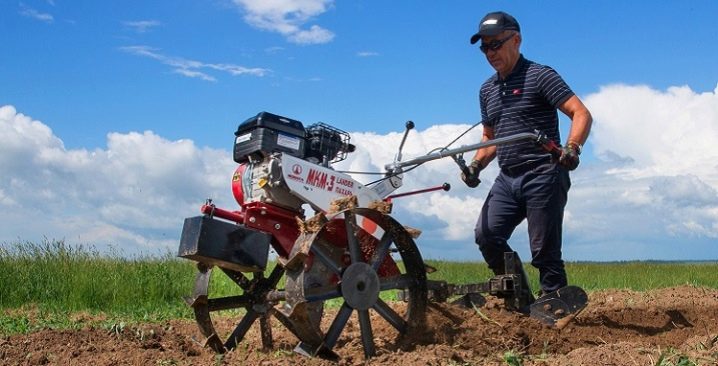
The lug is a popular type of attachment and is widely used in various spheres of human activity. The popularity of the device is due to its simple design, long service life, low cost and the possibility of self-manufacturing.
Appointment
One of the most common uses for lugs is walk-behind tractors and motor-cultivators. And although some modern means of small-scale mechanization have these devices in their basic configuration, more often they still have to be bought separately from the unit or made by hand.
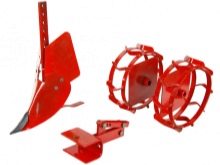
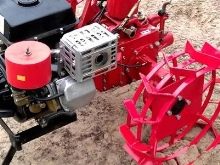

Lugs are used in cases where it is necessary to increase the adhesion of equipment to the ground and thereby increase its tractive effort and cross-country ability. So, walk-behind tractors equipped with grousers behave much more confidently on loose and clay soils and become more stable. This allows the walk-behind tractor to perform fairly deep soil cultivation without the risk of getting bogged down or burrowing into the ground. In addition, the use of lugs for mini-tractors and cars significantly increases their cross-country ability in off-road or muddy conditions.
However, the use of lugs for agricultural and road machinery is not limited.
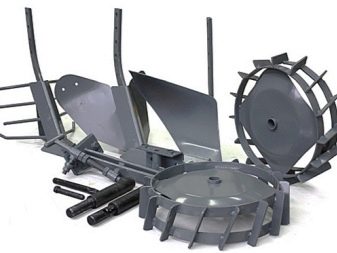
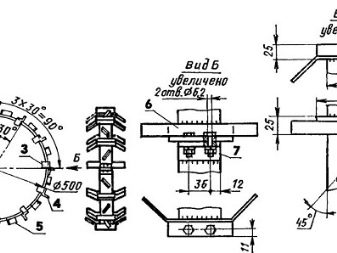
In a slightly modified form, the devices are used to secure the greenhouses more firmly on the ground., as well as for tying a wooden foundation to the ground. Construction lugs are arranged somewhat differently than wheel lugs, and are rods of metal reinforcement up to one meter long with a die welded at one end. To strengthen the structure, the rod is driven into the ground, and the above-ground part is screwed to a wooden foundation or the base of the greenhouse. Thanks to the use of T-shaped lugs, buildings can withstand strong wind loads, as well as seasonal ground movements.

Specifications and dimensions
Grousers for agricultural machinery are metal wheels or overhead rims equipped with a powerful tread that goes deep into the ground and reliably adheres the equipment to the ground. Highly hardened steel is used as a material for their manufacture, due to which the devices are practically indestructible and can serve for more than a dozen years. An important working parameter of lugs for walk-behind tractors and mini-tractors is their diameter and weight.
It depends on these indicators how well the unit will perform its work on plowing the land, removing weeds, hilling various crops and removing snow. So, the minimum weight of the simplest metal wheels should not be less than 20 kg, otherwise the use of this equipment will lose its meaning, and the benefits from it will be minimal. If the lugs, often homemade, do not reach the above standard, then they are used in combination with weighting agents, the presence of which provides the equipment with the necessary weight.
The heaviest models of hooks are installed on walk-behind tractors and mini-tractors used in off-road conditions, as well as in the development of virgin lands and for processing heavy rocky soil.
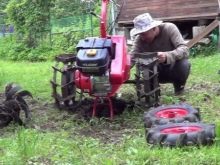
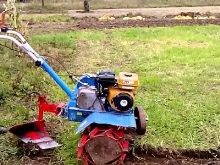

In addition to the weight of the lugs, the size of the lugs is also important.The diameter of the factory models ranges from 300 to 700 mm, and the width ranges from 100 to 200 mm. The most popular are considered models Patpiot 490001070 and a device for motoblocks Celina, Cascade, Kadvi and Neva.
The dimensions of these devices are 400x180 and 480x190 mm, respectively. The models are suitable for most domestic machines and are used for plowing soft soils, removing weeds and cutting furrows. No less popular and Patriot S-24 modelweighing 11 kg and measuring 390x120 mm. It can be used to loosen the ground, fight weeds and remove snow. More overall devices measuring 500x200 mm can be used in combination with a plow, and samples of 700x130 mm are used with potato diggers and flat cutters.
Grousers for motor cultivators have more modest dimensions than models for walk-behind tractors. So, popular with domestic farmers "Tarpan" and "Neva" weigh only about 5 kg, have a diameter of 280 mm and a width of 90 mm. Such devices are used for loosening light soils and working with single-row hillers.

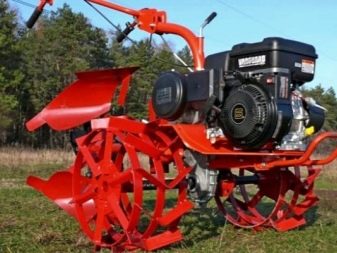
Varieties
The modern agricultural machinery market presents a wide selection of various wheel models, which are classified according to several criteria. The main criterion for distinguishing lugs is their design.
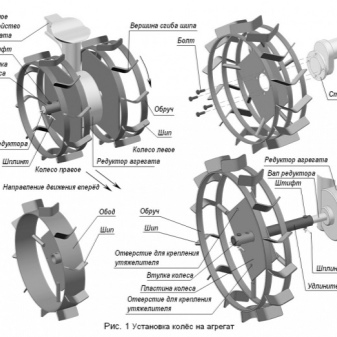
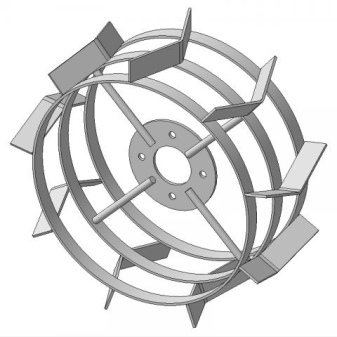
There are two types of wheel lugs.
The first one is products made in the form of one or more welded metal rims equipped with cone-shaped spikes or corner plates welded at a certain angle. Such a structure is installed instead of native wheels, and the fastening takes place using special brackets. The advantages of the species include high efficiency in soil cultivation, and good cross-country ability of the unit. The downside is the need to "change shoes" the walk-behind tractor, which is a rather lengthy and time-consuming process.


The second type is represented by lugs made in the form of metal nozzles, which are installed on top of ordinary wheels and do not require installation on the axis of the walk-behind tractor. Structurally, such models can be made in the form of chains or rims equipped with metal spikes. Outwardly, such models vaguely resemble conventional anti-slip chains for cars.
The “crab” design, which consists of metal strips fixed with an “accordion” with the edges bent in the form of hooks, has also proven itself well. The hooks are put on the tire of the wheel, and the brackets are fixed with a special lock-limiter.
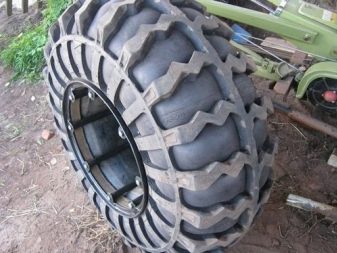
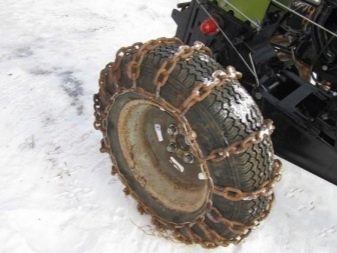
This type of lug is especially popular with SUV owners and has worked well on bumpy slushy roads with a lot of mud and clay. The advantage of this type of lug is quick installation and low cost in comparison with metal wheels. The disadvantages include a slightly lower cross-country ability and the need for additional use of weighting materials.
The next classification criterion is the compatibility of the lugs with various equipment. On this basis, special and universal devices are distinguished. And if the former are designed for a specific model of agricultural or road equipment, the latter are compatible with most of them, and can be installed on almost any unit. The advantage of specialized samples is a higher efficiency and versatility, and the advantages of station wagons include their practicality and the ability to use in relation to any technique. In addition, such models are much easier to sell if they are not needed.
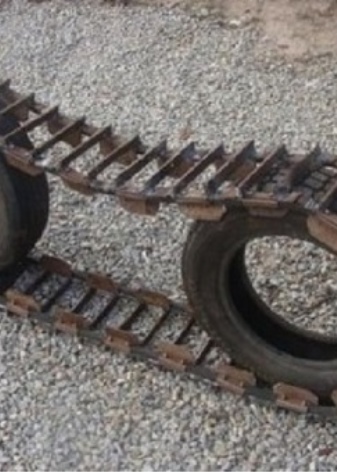

How to choose?
When buying a grouser for a walk-behind tractor or a car, it is necessary to choose the correct size of the device. And if for a car it is quite simple to do this, and you just need to know the diameter of the wheels, then when choosing equipment for a walk-behind tractor, you should also take into account the weight of the equipment.So, for heavy-duty models weighing more than 200 kg, it is recommended to purchase wide lugs with a diameter of at least 70 cm.For middle-class aggregates weighing about 80 kg, it is better to choose devices with a diameter of 30 to 40 cm. For very light models weighing up to 50 kg, and also narrow hooks 9 cm wide and 28 cm in diameter are suitable for motor cultivators.
The next selection criterion is the type of thorns. These can be wedge-shaped plates located on the rims or metal pins made from reinforcement, and on homemade models you can often see an angle welded at a certain angle.
The type of metal protector is selected based on the structure of the soil and the purpose of the lugs. So, when plowing virgin lands, it is better to choose a model with sharp thorns, while devices with a deep oblique or wedge-shaped tread more than 10 cm high are suitable for working on wet chernozems, clay and loose soils.

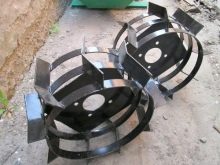

Operating rules
For efficient and correct operation of the technique, the lugs must be correctly installed. To do this, they are put on the wheel shafts of the walk-behind tractor and fixed with special brackets. When installing the hooks on the cultivators, they are placed on the gearbox shaft and secured with pins. If the lug is selected and installed according to all the rules, then its spikes will not touch the unit parts, and when viewed from above, the tops of the wedge-shaped spikes will look forward in the direction of the unit movement.
If the walk-behind tractor or cultivator remains too light even after the installation of the lugs, then the installation of weighting materials is necessary. When using the machine equipped with any kind of hooks, it is strictly forbidden to drive on an asphalt, metal or concrete surface.
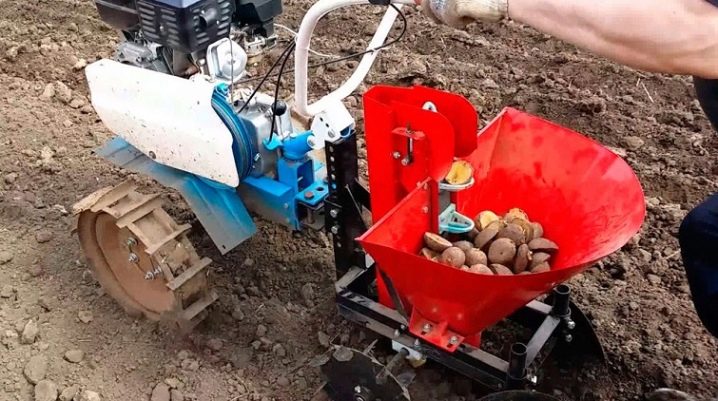
When using lugs, safety precautions must be followed. To do this, before starting work, you must carefully read the operating instructions, and also check the serviceability of the engine and the reliability of the threaded connections of the unit.
Then it is recommended to walk along the treated area and remove mechanical debris, dry branches and large stones from its territory. And you also need to make sure that there are no electrical wires, metal cables and water hoses on the ground. And only after the field is prepared, you can start working.
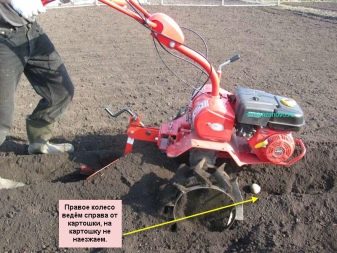
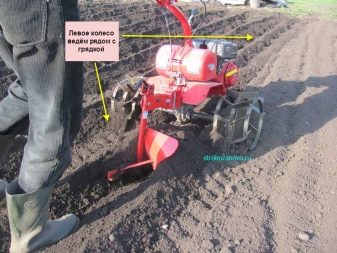
When moving vehicles in reverse, as well as when making turns, you need to be especially careful: during sharp maneuvers, spikes can turn a stone out of the ground, and no one knows where it will fly. This is especially true for powerful lugs with a large cleat height.
At the end of the work, the lugs should be cleaned of soil residues and treated with universal grease or lithol. Store the devices in a dry ventilated area away from sources of moisture. With the right choice, careful operation and proper storage, the lugs do not fail for a very long time and serve their owners for many years.
For information on how to choose the right lug for a walk-behind tractor, see the next video.




























































The comment was sent successfully.